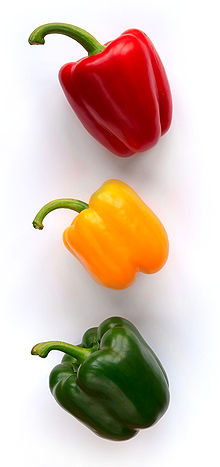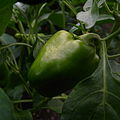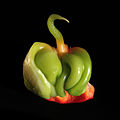- Bell pepper
-
Bell pepper, also known as sweet pepper or a pepper (in the UK) and capsicum (in Australia and New Zealand), is a cultivar group of the species Capsicum annuum (chili pepper). Cultivars of the plant produce fruits in different colors, including red, yellow, orange and green. Bell peppers are sometimes grouped with less pungent pepper varieties as "sweet peppers". Peppers are native to Mexico, Central America and northern South America. Pepper seeds were later carried to Spain in 1493 and from there spread to other European, African and Asian countries. Today, China is the world's largest pepper producer in the world, followed by Mexico.
Contents
Nomenclature
Bell pepper Heat None (SR:0) The misleading name "pepper" (pimiento in Spanish) was given by Christopher Columbus upon bringing the plant back to Europe. At that time peppercorns, the fruit of Piper nigrum, an unrelated plant originating from India, were a highly prized condiment; the name "pepper" was at that time applied in Europe to all known spices with a hot and pungent taste and so naturally extended to the newly discovered Capsicum genus. The most commonly used alternative name of the plant family, "chili", is of Central American origin. Bell peppers are botanically fruits, but are generally considered in culinary contexts to be vegetables.
While the bell pepper is a member of the Capsicum genus, it is the only Capsicum apart from Capsicum rhomboideum that does not produce capsaicin,[1] a lipophilic chemical that can cause a strong burning sensation when it comes in contact with mucous membranes. The lack of capsaicin in bell peppers is due to a recessive form of a gene that eliminates capsaicin and, consequently, the "hot" taste usually associated with the rest of the Capsicum genus.[2]
The terms "bell pepper", "pepper" or in Australia and New Zealand "capsicum", are often used for any of the large bell shaped fruits, regardless of their color. In British English, the fruit is simply referred to as a "pepper", or additionally by colour (as in the term "green pepper", for example), whereas in many Commonwealth of Nations countries, such as India and Malaysia, they are called "bell peppers". Across Europe, the term "paprika", which has its roots in the word for pepper, is used—sometimes referred to by their color (e.g., "groene paprika", "gele paprika", in Dutch, which are green and yellow, respectively). Paprika also refers to the powdered spice made from the fruits in the Capsicum genus.[3] In France, it is called "poivron", with the same root as "poivre" (meaning "pepper"), or "piment". In Korea, the word 피망 ("piman" from the French) refers to green bell peppers, whereas 파프리카 ("papurika" from paprika) refers to bell peppers of other colors.
Varieties
The color can be green, red, yellow, orange and more rarely, white, rainbow (between stages of ripening) and purple, depending on when they are harvested and the specific cultivar. Green peppers are less sweet and slightly more bitter than yellow or orange peppers, with red bell peppers being the sweetest. The taste of ripe peppers can also vary with growing conditions and post-harvest storage treatment; the sweetest are fruit allowed to ripen fully on the plant in full sunshine, while fruit harvested green and after-ripened in storage are less sweet.
Nutritional value
Pepper, sweet, green raw Nutritional value per 100 g (3.5 oz) Energy 84 kJ (20 kcal) Carbohydrates 4.64 g - Sugars 2.40 g - Dietary fiber 1.7 g Fat 0.17 g Protein 0.86 g Vitamin A equiv. 18 μg (2%) Thiamine (vit. B1) 0.057 mg (5%) Riboflavin (vit. B2) 0.028 mg (2%) Niacin (vit. B3) 0.480 mg (3%) Pantothenic acid (B5) 0.099 mg (2%) Vitamin B6 0.224 mg (17%) Folate (vit. B9) 10 μg (3%) Vitamin C 80.4 mg (97%) Calcium 10 mg (1%) Iron 0.34 mg (3%) Magnesium 10 mg (3%) Phosphorus 20 mg (3%) Potassium 175 mg (4%) Zinc 0.13 mg (1%) Percentages are relative to US recommendations for adults.
Source: USDA Nutrient DatabaseCompared to green peppers, red peppers have more vitamins and nutrients and contain the antioxidant lycopene. The level of carotene, like lycopene, is nine times higher in red peppers. Red peppers have twice the vitamin C content of green peppers.[4] Also, one large red bell pepper contains 209 mg of vitamin C, which is almost three times the 70 mg of an average orange.
Production
Bell and Chile pepper production (tonnes)[5] Country 2004 2005 2006 2007  China
China12,031,031 12,530,180 13,031,000 14,033,000  Mexico
Mexico1,431,258 1,617,264 1,681,277 1,690,000  Indonesia
Indonesia1,100,514 1,058,023 1,100,000 1,100,000  Turkey
Turkey1,700,000 1,829,000 1,842,175 1,090,921  Spain
Spain1,077,025 1,063,501 1,074,100 1,065,000  United States
United States978,890 959,070 998,210 855,870  Nigeria
Nigeria720,000 721,000 721,500 723,000  Egypt
Egypt467,433 460,000 470,000 475,000  Korea, South
Korea, South410,281 395,293 352,966 345,000  Netherlands
Netherlands318,000 345,000 318,000 340,000  Romania
Romania237,240 203,751 279,126 280,000  Ghana
Ghana270,000 270,000 277,000 279,000  Italy
Italy362,430 362,994 345,152 252,194  Tunisia
Tunisia255,000 256,000 256,000 250,000  Algeria
Algeria265,307 248,614 275,888 233,000  Hungary
Hungary126,133 113,371 206,419 207,000  Morocco
Morocco182,340 190,480 235,570 192,000  Serbia*
Serbia*159,741 167,477 177,255 150,257  Japan
Japan153,400 154,000 146,900 150,000  Israel
Israel129,100 134,700 150,677 136,000 World 24,587,124 25,261,259 26,252,907 26,056,900 - Note: Serbia before 2006 incl. Montenegro
Gallery
See also
References
- ^ http://www.chiliwonders.com/chili.scoville.htm
- ^ "The World's Healthies Foods". http://whfoods.com/genpage.php?tname=foodspice&dbid=50. Retrieved February 23, 2010.
- ^ Azhar Ali Farooqi; B. S. Sreeramu; K. N. Srinivasappa (2005). Cultivation of Spice Crops. Universities Press. pp. 336–. ISBN 9788173715211. http://books.google.com/books?id=7KPUlXxOYZAC&pg=PA336. Retrieved 22 August 2010.
- ^ http://www.fitsugar.com/node/167874/results
- ^ "Table 64--World bell and chile peppers: Production 1990-2007". United States Department of Agriculture. http://usda.mannlib.cornell.edu/usda/ers/BellAndChile/Table64.xls. Retrieved 2011-05-08.
External links
Capsicum cultivars C. annuum C. chinense - Adjuma
- Ají Limo
- Ají dulce
- Datil
- Fatalii
- Habanero
- Hainan Yellow Lantern Chili
- Madame Jeanette
- Naga Jolokia
- Red Savina Habanero
- Scotch bonnet
C. frutescens C baccatum C. pubescens Categories:- Chili peppers
- Crops originating from the Americas
Wikimedia Foundation. 2010.










